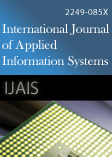
- Seema Singh and Mandeep Singh 2012. Software Defect Prediction using Adaptive Neural Networks. International Journal of Applied Information Systems. 4, 1 (September 2012), 29-33. DOI=http://dx.doi.org/10.5120/ijais450612
-
@article{10.5120/ijais2017451568, author = {Seema Singh and Mandeep Singh}, title = {Software Defect Prediction using Adaptive Neural Networks}, journal = {International Journal of Applied Information Systems}, issue_date = {September 2012}, volume = {4}, number = {}, month = {September}, year = {2012}, issn = {}, pages = {29-33}, numpages = {}, url = {/archives/volume4/number1/265-0612}, doi = { 10.5120/ijais12-450612}, publisher = { xA9 2010 by IJAIS Journal}, address = {} } -
%1 450612 %A Seema Singh %A Mandeep Singh %T Software Defect Prediction using Adaptive Neural Networks %J International Journal of Applied Information Systems %@ %V 4 %N %P 29-33 %D 2012 %I xA9 2010 by IJAIS Journal
Abstract
We present a system which gives prior idea about the defective module. The task is accomplished using Adaptive Resonance Neural Network (ARNN), a special case of unsupervised learning. A vigilance parameter (?) in ARNN defines the stopping criterion and hence helps in manipulating the accuracy of the trained network. To demonstrate the usefulness of ARNN, we used dataset from promisedata. org. This dataset contains 121 modules out of which 112 are not defected and 9 are defected. In this dataset modules are termed as defected on the basis of three measures that are LOC, HALSTEAD, MCCABE measures that have been normalized in the range of 0-1. We see that at ?=0. 1858 the network has maximum Recall (i. e. true negative rate) is 100% and average Precision=54%. In case of ART n/w shortfalls are seen forAccuracy as this is a subjective measure.
References
- M. Bahrololum, E. Salahi, and M. Khaleghi, 2009, Anomaly Intrusion Detection Design using Hybrid of Unsupervised and Supervised Neural Network, International Journal of Computer Networks & Communications pp. 26-33.
- Venkata U. B. Challagulla, FarokhB. Bastani,I-Ling Yen2005 "Empirical Assessment of machine learning based software defect prediction techniques". Words'05 Proceedings of the 10th IEEE International Workshop on Object-Oriented Real-Time Dependable Systems pp 263-270,.
- Mie MieThetThwin,Tong-SengQuah2003 "Application of neural networks for software quality prediction using object-oriented metrics" ICSM '03 Proceedings of the International Conference on Software Maintenancepp116.
- NcahiappanNagappan2005"Static Analysis Tools as early Indicators of pre-release defect density" ICSE '05Proceedings of the 27th international conference on Software engineering pp 580-586.
- Rudolf Ramer, Klaus Wolfmair,ErwinStauder, Felix Kossak and Thomas Natschlager 2009 "Key Questions in Building defect prediction models in practice"Software Competence Center HagenbergSoftwarepark 21, A-4232 Hagenberg, Austria, pp. 14–27.
- Zeeshan Ali Rana,Mian Muhammad Awais and ShafayShamail 2009 "An FIS for early defect prone modules"Springer-Verlag Berlin Heidelberg ,pp. 144–153.
- G. Boetticher, T. Menzies, and T. Ostrand, PROMISE Repository of Software Research Laboratory (Softlab),Bogazici University, Istanbul, Turkey, 2007, http://promisedata. org/ repository.
- K. Mehrotra, C. K. Mohan, and S. Ranka, Elements of Artificial Neural Networks (Massachusetts Institute of Technology, MA, 2000).
- Martin Neil and Norman Fenton 1996 " Predicting software quality using Bayesian Belief Networks".
- Todd L. Graves, Alan F. Karr, J. S. Marron and Harvey Siy 2000 "Predicting Fault Incidence Using software change history". IEEE transactions of software engineering.
Keywords
Resonance, Clustering, Unsupervised learning, Confusion metrics
 10.5120/ijais12-450612
10.5120/ijais12-450612
